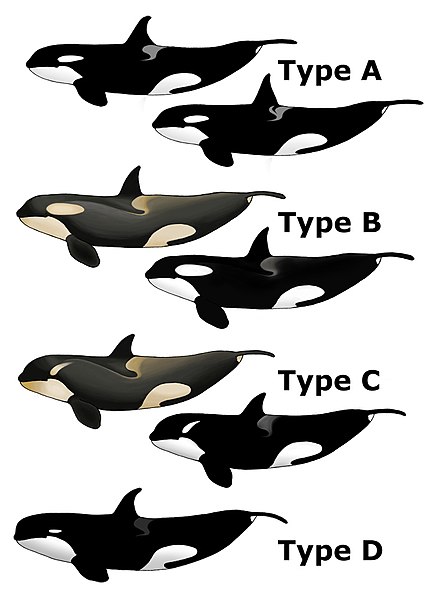What made me wonder was the paper by Pitman, et. al., on an orca called Type D. Type D, it seems, is a rarely observed but very distinctive orca that may be a separate species. It's relatively small for an orca, and has a tiny eyepatch and no gray dorsal "cape" marking. In other words, it's not a perfect match to Wilson's whale - he'd have had to miss the eyepatch in his observations - but it looks more like it than any creature yet documented.
Wilson's whale. Note the white underside in the top picture.(I believe the picture, copied from Heuvelmans here, to be out of copyright: if anyone knows differently, please tell me).

Type D (Wikimedia Commons)
The dates of sighting are given as 28 and 29 January: Discovery stopped at Cape Crozier on 22 January and reached and named King Edward Land on 30 January, so my amateur reckoning puts them between 76 and 77 South. This creates a problem. The Type D has not definitely been identified below 60, and Robert Pitman told me in correspondence he can't imagine it goes below 65 or so - the water is just too cold for it. As for the visual match, Pitman writes, "Intriguing speculation but it would be difficult to say with any certainty - just not quite enough in the illustrations to be convincing." He doesn't have an opinion on what Wilson's whale was, though he notes that, at the time, there was thought to be just one species of orca (heck, a hundred years after Wilson that's still what we thought) and it wasn't clear whether Wilson was saying his whale was not an orca (I have to get Wilson's book on the expedition).
Anyway, Wilson's whale is a mystery. I thought for a bit there I'd solved it, but no. If it was a Type D orca, it was way out of its range, and if it was some other orca, then Wilson could hardly have missed the markings. So what was it? An odd orca of another type, one with minimal markings? An unknown type orca? Something else entirely?
Whales still have their secrets.
Thanks to Robert L. Pitman

2 comments:
Interesting article thanks. My first thought was that the whale in Wilson's photo was a baleen because the dorsal is so far back. Also, in the top photo it seemed the white area was an open mouth, but alas, I cannot find any record of a baleen with a tall dorsal like this. Search on...
Good thought: I'd always assumed it was some type of orca. If it was baleen, it would have to be an unknown species with that fin.
Post a Comment